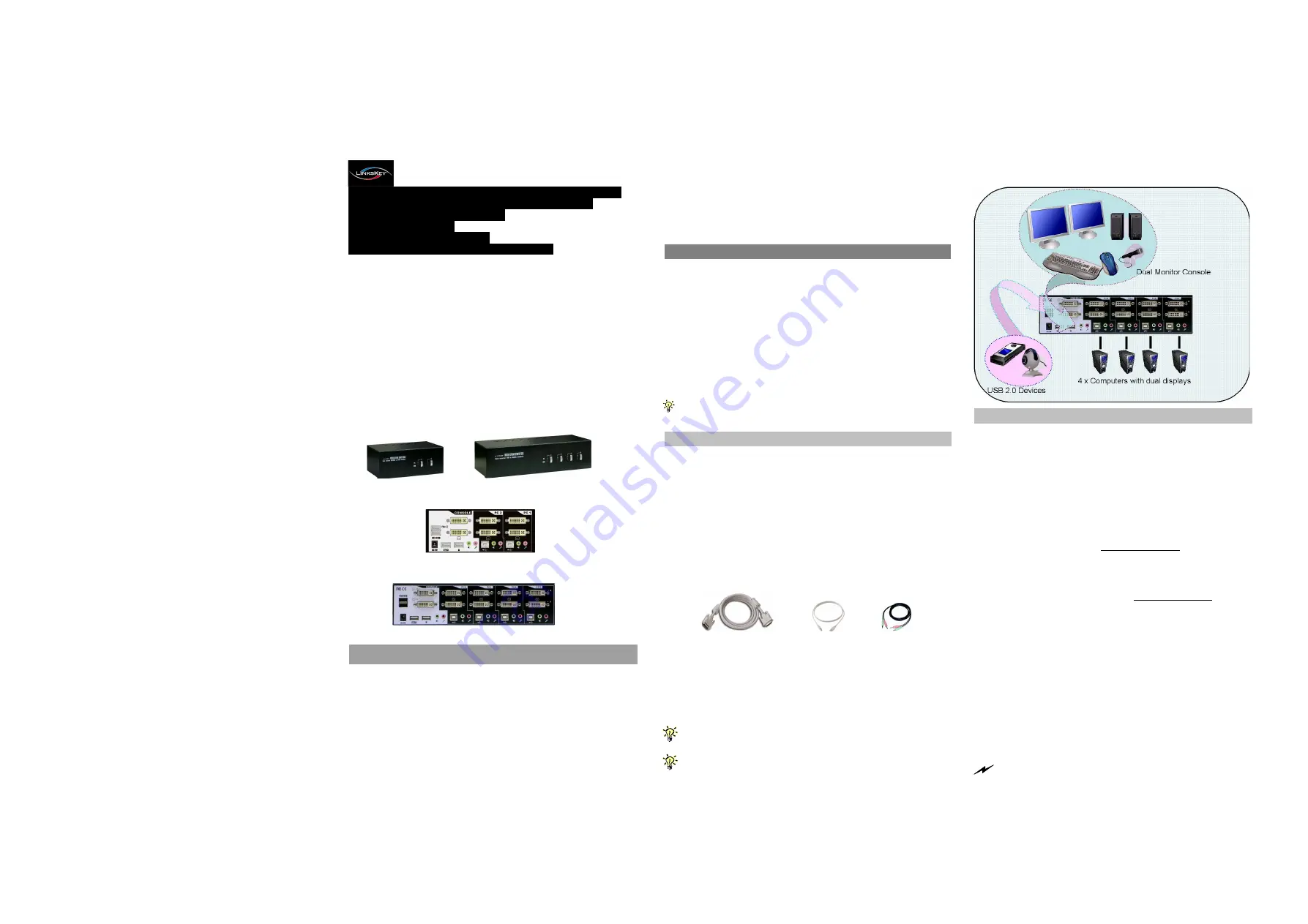
Dual Monitor Console
4 x Computers with dual displays
USB 2.0 Devices
Quick Installation Guide
Applicable models: LDV-DM202AU/LDV-DM204AU 2/4-port Dual Monitor DVI KVM Switch w/ Audio&Mic
True Transparent USB Emulation for keyboard and mouse
All-Time Full DDC Emulation for Video Compatibility
Digital and Analog Video Support
2 x USB 2.0 Hub Ports
Audio&Mic Switching Support
User-Definable Hotkey Preceding Sequence
LDV-DM202AU/LDV-DM204AU
2/4-port Dual Monitor DVI KVM Switch
w/ Audio&Mic
True Transparent USB Emulation
Quick Installation Guide
Thank you for purchasing the
LDV-DM202AU / LDV-DM204AU
Dual Monitor DVI KVM Switch w/ Audio&Mic
! With our highly
reliable and quality product, user can enjoy countless benefits
from using this KVM switch.
LDV-DM202AU
LDV-DM204AU
LDV-DM202AU - Back Panel
LDV-DM204AU – Back Panel
Introduction
The
LDV-DM202AU / LDV-DM204AU
Dual Monitor DVI KVM
Switch
utilizes the latest
True Transparent USB (TTU)
Emulation Technology
to ensure full compatibility to all USB
keyboards and mice and also guarantee fastest switching
speed. By using the TTU Technology, KVM users will no
longer
suffer any comprise to keyboard and mouse
functionalities and can enjoy their full capability. Hence this KVM
switch is especially designed for use with gaming keyboard
and gaming mouse. Its two extra USB 2.0 hub ports are for
sharing high-speed USB 2.0 devices. Thus, your investment on
this KVM switch is further ensured and its life-time value just
The
LDV-DM202AU / LDV-DM204AU
supports
All-Time Full DDC
Emulation
so that it can guarantee a maximum compatibility with
video requirements. It supports digital resolution up to 1920 x 1200,
analog resolution up to 2048 x1536.
Before you install
The default setting of the
LDV-DM202AU / LDV-DM204AU
is
appropriate for most systems. You do not need to configure the
KVM switch before installation. Please follow the instructions below
for the setup sequence:
The correct setup sequence is …
( 1 ) Power up your KVM switch by connecting the external power
adapter to it.
( 2 ) Then connect the shared keyboard, mouse, monitors also
speakers, and microphone to the KVM switch, then connect
your computers one by one.
Since USB interface is hot-pluggable, you don’t have t o turn off the computer before
making connections to the KVM switch.
Out-of-the-box Installation
Take the KVM switch out of the box and begin installation….
Step 1.
Power up your KVM switch by connecting the external
power adapter to it.
Step 2.
Connect the shared USB keyboard, mouse, two monitors,
speakers, and microphone as well as other shared USB
devices to the KVM switch.
Step 3.
Connect each of your computers to the KVM switch using
the DVI-D video cable, USB (Type A -to- Type B) cable,
audio and microphone cables (cables not included).
DVI – D
USB cable
Audio/Mic
Video Cable
(Type A -to- Type B)
Cables
Step 4.
(
Now your KVM switch should have been powered-up….
)
Power up the connected computers one by one. After your
computers are powered up, the keyboard and mouse
will be recognized and now you can begin operating the
KVM switch.
And also you should verify the USB devices on your USB Hub p orts
are fully functioning after installation of its drivers on both connected PCs.
If you need to connect to a analog video source (VGA) you might
need to use a D V I - V G A a d a p t e r f o r m o n i t o r a n d DVI-I video
cable with DVI-VGA adapter to facilitate connection with the KVM switch.
Easy Operation
There are two methods to control your KVM switch for PC,
USB Hub ports as well as audio/mic channel selection: using
the
front- panel push button or a keyboard hotkey sequence.
Front-Panel Push Button
The front-panel push buttons let you have direct control over
KVM switch operation and channel switching. Simply press the
desire button for PC channel sw itching. If you want to enable the
binding of PC / USB H ub ports / Audio/Mic switching, use the
keyboard hotkey sequences.
See Quick Reference Sheet
Keyboard Hotkey Sequence
A keyboard hotkey sequence consists of at least three specific
keystrokes (console keyboard only):
See Quick Reference Sheet
Hotkey sequence = [ScrLk]
*
+ [ScrLk]
*
+
Command key(s)
* User-definable = SCROLL LOCK
,
CAPS
,
ESC
,
F12
or
NUM LOCK
Keyboard hotkey preceding sequence configuration:
For users who want to use a preceding sequence other than two
consecutive Scroll Lock keys, f oll o w t he s t e ps b el o w to configure
it.
(1)
Hit Scroll-Lock and Scroll-Lock then H, two beeps will signal
readiness for new preceding sequence selection or press and hold
down the last front-panel push button (button 2/4) until you hear two
beeps, then release the button.
(2)
Select and press the key you would
like to use as your preceding sequence (
SCROLL LOCK
,
CAPS
,
ESC
,
F12 or NUM LOCK
keys are available for selection) and you’ll hear a
beep for selection confirmation. Now you can use the new preceding
sequence to execute your keyboard hotkey commands.
Each keystroke within a hotkey sequence should be pressed
within 2 seconds. Otherwise, the hotkey sequence will not be validated.
Rev. 1.8
Copyright© All rights reserved


